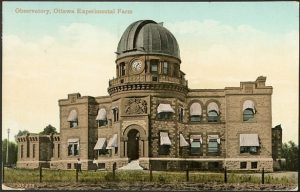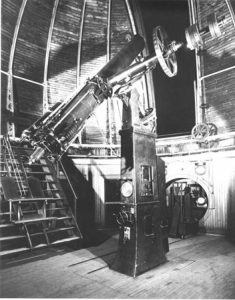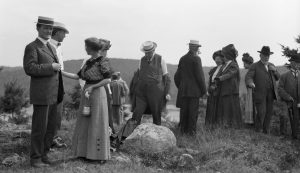A New Direction for Canadian Science
Early Canadian scientific efforts were mainly tied to resource extraction and development, rather than physical sciences. Nevertheless, Canadian astronomy in the nineteenth century had very practical applications. It used measurement of stars for two things: accurately determining the nation’s time and aiding geographic surveys by measuring longitude.
In 1905, the Dominion Observatory opened in Ottawa. This observatory was primarily dedicated to astronomical timekeeping for the nation, and the master clock at the observatory transmitted the time to seven hundred clocks throughout Ottawa.
In terms of geography, the mountain ranges in western Canada hampered accurate land surveys in that part of the country, but traditional approaches could be supplemented by astronomical measurements for better results.
Plaskett was in charge of the new astrophysics work at the observatory, and his work represented Canada’s main effort in the new field of astrophysics. He used the 15-inch refracting telescope to study stars and determine their velocity. He was also mechanically gifted and made many improvements to the telescope.
Plaskett eventually reached the limit of what a telescope this size could do, so he made several additional improvements that allowed him to continue his work. At the time, larger and larger telescopes were being built in the US. Their capabilities exceeded those of the modest Ottawa telescope, and Plaskett realized that Canada needed a comparable instrument.
Plaskett’s idea to build a bigger telescope received strong support from US astronomers at a 1910 meeting of the International Union for Cooperation in Solar Research in California. The following year in Ottawa, a meeting of astronomers passed a resolution, later presented to the Minister of the Interior, emphasizing the rationale for a new telescope in Canada. Unfortunately, soon after this resolution was passed, a general election resulted in a new government and the case had to be made all over again. Another obstacle arose when a new Minister of the Interior was appointed.
Undeterred, Plaskett continued to gather support for the telescope. He lobbied government officials and encouraged distinguished astronomers in Europe and the US to send letters of support. Plaskett “haunted the lobbies [of Parliament] practically every morning for two months, attempting to find members, on the government side, who were interested in astronomy, to intervene with the Minister.” (Plaskett, J.S., 1983, JRASC, 77, 109. This manuscript (previously unpublished) was found 40 years after Plaskett’s death).
Plaskett’s efforts finally paid off in 1913, when the government agreed to fund the construction of the large telescope that would change Canadian astrophysics and Plaskett’s life forever.




